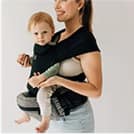How to Prevent Neck and Shoulder Pain from Holding a Baby
Written by Yotpo Collaborator on May 03, 2020.
Babies may be small, but carrying them day in and day out can add up—especially on your neck and shoulders. While it’s easy enough with tiny newborns, they grow rapidly, and those sweet cuddles add up over time.
In this guide, we’ll break down what causes pain in your shoulder and neck, share practical tips on how to relieve neck and shoulder pain, and highlight other aches to watch for when carrying your baby.
Table of Contents
- How to Relieve Neck and Shoulder Pain While Holding a Baby
- What Causes Neck and Shoulder Pain from Holding a Baby?
- Other Pains to be Mindful Of: Back, Wrist and Elbow
- FAQs
How to Relieve Neck and Shoulder Pain While Holding a Baby
There are a few practical ways to relieve neck and shoulder pain from carrying your baby—including the tips below.
Posture Adjustments to Prevent Pain
When you’re carrying your baby, posture is everything. Keep your weight balanced and your posture in check to avoid neck and shoulder pain. Avoid leaning to one side or hunching forward, as these habits can add unnecessary strain.
If you’re carrying your baby without the support of a carrier, hold them close to your center so their weight is evenly distributed. This makes it easier for you to stand up straight with your head, neck, and pelvis aligned.
Even when using a carrier, there are still a few things to be conscious of. Your body may naturally compensate by leaning away from the weight. Try to resist slumping and keep your posture balanced to reduce strain.
Posture is also essential when breastfeeding. Discover the best posture for breastfeeding in our Breastfeeding Posture Support guide.
Stretches to Relieve Neck and Shoulder Pain
A few simple stretches can make a big difference in relieving pain in the shoulder and neck from holding a baby. Here are a handful of our favorites:
-
Shoulder blade stretch: Relax your shoulder blades and pull them gently down and back, like you’re trying to squeeze something between them. Hold this for three seconds and repeat up to 15 times.
-
Neck stretch (when empty-handed): Lie on the floor on your back with a small, rolled-up towel under your neck. This stretch alleviates pressure from the discs of your neck. Spend up to 5 minutes in this stretch a couple of times a day.
-
Neck stretch (while holding Baby): When holding or feeding your baby, try tilting your head to one side, feeling the stretch between your neck and shoulder. Keep your shoulders relaxed, and repeat on both sides for up to 30 seconds 1-3 times daily.
You can also reduce neck and shoulder pain during feedings with the Tushbaby Hip Carrier, which doubles as a supportive nursing pillow. When used as a nursing pillow, the Tushbaby elevates your baby to the proper height, supporting their weight so you don’t have to hunch forward and strain your shoulders and neck.
Learn other stretches (and get more details on the ones we explored above) in this Bright Side guide.
Invest in a Good Carrier
Investing in a good baby carrier is another great way to relieve shoulder and back pain while holding a baby.
There are so many different types of baby carriers to choose from, and some are better than others when it comes to preventing neck and shoulder pain. When considering a carrier to keep pain at bay, look for one designed with support in mind—like the Tushbaby Hip Carrier.
Other carriers can be difficult to use and get the right fit, but Tushbaby keeps it simple with an adjustable waistband that velcros tight and secures with a locking buckle. It offers four different carrying positions, giving you the flexibility to switch things up while keeping your posture upright and your body properly aligned.
By evenly distributing your baby’s weight across your hips, the Tushbaby Hip Carrier takes the strain off your arms and upper body. The sturdy, padded seat sits high and tight above your natural waist, preventing hunching, slumping, or leaning—so you can carry comfortably with less tension on your neck and shoulders.
Lift Your Little One Smartly
Lifting with your legs rather than your back can help prevent strain over time. It’s easy to scoop up your baby without thinking, but repetitive lifting can take a toll on your body, leading to neck and shoulder pain.
To protect your posture, bend at your knees and hips—not your waist—when picking up your baby. Hold them close to your chest and push up through your legs, keeping your core engaged and your back straight. Avoid twisting your torso while lifting to prevent unnecessary strain.
At-Home and Over-The-Counter Pain Relief
Over-the-counter and at-home remedies can also offer relief from the daily aches of baby carrying. Here are a few simple remedies to try:
-
Use a heating pad
-
Apply a cold pack or frozen peas to the affected area
-
Take medication (approved by your doctor)
-
Rest with a cushion behind your lower back
When to Seek Professional Help
While the occasional neck and shoulder pain is part of parenting’s not-so-fun perks, pain that sticks around for more than two weeks—or feels severe from the start—deserves attention. Checking in with a doctor can help rule out anything serious and provide guidance on how to get rid of neck and shoulder pain for good.
What Causes Neck and Shoulder Pain from Holding a Baby?
You may not notice it at first, but the same repetitive motions done with improper form will leave you sore and out of alignment. Here are a few of the main reasons why you get neck and shoulder pain from holding your baby.
Poor Posture
Caring for a baby often means bending, lifting, and hunching in ways your body isn’t thrilled about. That’s why dialing in on proper posture while feeding, lifting, and carrying your baby is key to keeping those aches away.
Bending Forward Too Much
Grabbing your baby from the crib, changing table, or floor often means bending forward without thinking about form. These everyday movements may not seem like much, but over time, they put stress on your neck, shoulders, and back.
Repetitive Strain
Constantly lifting, carrying, and reaching for your baby can take a serious toll, putting repetitive stress on your muscles, tendons, and nerves.
Incorrect Lifting Techniques
Newborns are easy to pick up, but once your little one starts tottering around, you’re more likely to scoop them up quickly—and sometimes, with poor form. Lifting without engaging your core or bending at the knees can put extra strain on the wrong parts of your body.
Holding Your Baby Incorrectly
Holding your baby incorrectly can quickly lead to neck and shoulder pain, and it’s no surprise why. As your baby grows, carrying them becomes more challenging, often forcing you to lean awkwardly or favor one side to compensate.
While holding your child on your hips feels natural, especially as they grow and want up and down often, this uneven weight distribution can affect your posture and muscles. Add in the strain of carrying a car seat or slinging a heavy diaper bag over one shoulder, and it’s no wonder so many parents struggle with constant neck, shoulder, and back pain. That’s where the Tushbaby Hip Carrier comes in. Designed with five storage pockets, it helps you carry more than just your baby—eliminating the need for an extra bag weighing you down.
Avoiding neck and shoulder pain starts with being mindful of how you hold and carry your little one, ensuring your posture stays aligned and the weight is evenly supported.
Other Pains to be Mindful Of: Back, Wrist and Elbow
Neck and shoulder pain aren’t the only aches baby carrying can give you. Your back, wrists, and elbows can also take a hit if you’re not careful.
Back Pain from Holding Baby
You can also get back pain from holding baby. Similar to neck and shoulder pain, this back pain can be caused by incorrect lifting and poor posture.
How to relieve back pain from carrying baby will be similar to how you ease neck and shoulder pain. So, correct that posture, use a good carrier, and have proper support when nursing (i.e., a nursing pillow). Find out more in our guide on how to carry your baby without hurting your back.
Wrist Pain from Holding Baby
Wrist pain from holding baby is such a rite of passage for parents that it even has its own nickname: ‘Mother’s Wrist.’ Officially known as De Quervain’s tenosynovitis, it’s what happens when repetitive lifting—like picking up your baby for the millionth time—causes inflammation and pain in your thumb and wrist.
Changing your lifting technique could help alleviate some of the pressure. Instead of picking your baby up with your fingers on their back and thumbs on their chest, it might be handy to lift your baby from under their bottom with the palm of your hand facing up. This helps shift the weight off the problem zones.
Nursing can also strain your wrists if you put the full weight of baby’s head in your palm. If you think nursing is the culprit here, use a nursing pillow like the Tushbaby Hip Carrier to support the weight and reduce the pressure on your wrist.
Elbow Pain from Holding Baby
The rinse and repeat of lifting your baby (and doing so in a non-optimal way) can also put stress on your elbow, causing pain.
When elbow pain strikes, it’s time to reevaluate how you’re lifting your baby. When picking them up, keep your wrists stable and rigid to minimize the force applied to your elbow.
FAQs
Can a Chiropractor Help ‘Mom Shoulder’?
A chiropractor could help to relieve the shoulder pains associated with picking up your little one. However, it’s always best to seek professional medical advice before undergoing any sort of treatment for your parenting pains.
Want to keep your posture intact and your parenting stylish? Shop all Tushbaby products today!








1 comment
Thanks for the helpful article
Leave a comment